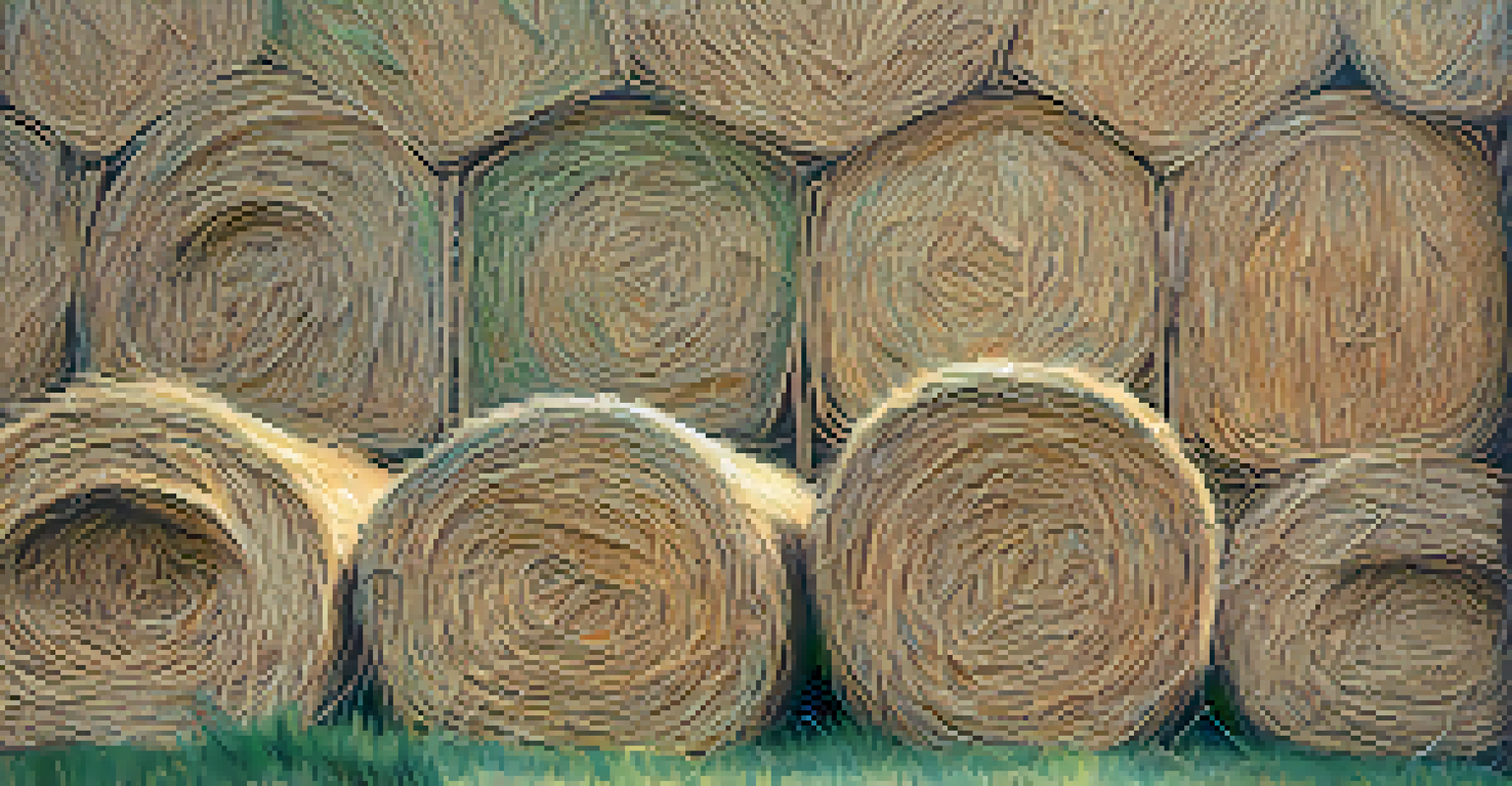Top 10 Sustainable Materials for Green Building in California

Why Sustainable Materials Matter in California's Building Industry
Sustainable materials play a crucial role in reducing the environmental impact of buildings. With California's commitment to green initiatives, using eco-friendly materials is not just a trend; it’s a necessity. By prioritizing these materials, builders can significantly lower carbon footprints while promoting energy efficiency.
The greatest threat to our planet is the belief that someone else will save it.
Furthermore, sustainable materials often lead to healthier living environments. They are typically sourced responsibly, reducing waste and pollution. For example, using reclaimed wood not only gives a unique character to a home but also diverts waste from landfills, contributing to a circular economy.
Ultimately, embracing sustainable materials is about more than just compliance; it’s about creating a legacy for future generations. California's natural beauty and diverse ecosystems deserve to be protected, and choosing the right materials is a step towards that goal.
1. Bamboo: The Fast-Growing Wonder Material
Bamboo has gained popularity as a sustainable building material due to its rapid growth and renewability. Unlike traditional timber, bamboo can mature in just three to five years, making it an excellent alternative that reduces deforestation. Its natural strength and flexibility also make it ideal for various applications, from flooring to structural components.

Moreover, bamboo absorbs more carbon dioxide than many trees, contributing positively to the environment. This means that using bamboo in construction can help offset some of the greenhouse gases produced during the building process. Plus, its unique aesthetic appeal adds a touch of warmth and elegance to any space.
Sustainable Materials Reduce Impact
Using eco-friendly materials in construction helps lower carbon footprints and promotes energy efficiency.
In California, where innovative design meets eco-consciousness, bamboo serves as a perfect blend of both. Builders are increasingly incorporating it into residential and commercial projects, showcasing how sustainability can be stylish.
2. Reclaimed Wood: A Story with Every Plank
Reclaimed wood tells a story, and using it in construction adds a unique charm to any project. Sourced from old barns, factories, or even demolished structures, reclaimed wood not only reduces the need for new lumber but also preserves the history embedded in each piece. This can create stunning architectural features that are both beautiful and rich in character.
We do not inherit the earth from our ancestors, we borrow it from our children.
In addition to its aesthetic value, reclaimed wood is often more durable than new wood, as it has already stood the test of time. When sourced responsibly, it can be a sustainable choice that minimizes waste and carbon emissions associated with new lumber production. Plus, it helps reduce the strain on forests, which is vital for environmental conservation.
California homeowners and builders are increasingly embracing reclaimed wood for everything from flooring to furniture. The trend not only supports sustainability but also fosters a deeper connection to the materials we use in our living and working spaces.
3. Rammed Earth: A Timeless and Durable Choice
Rammed earth is an ancient building technique that has made a modern comeback, particularly in eco-friendly construction. This method involves compacting a mixture of soil, sand, and gravel into forms to create solid walls. It’s not only energy-efficient but also highly durable, providing excellent insulation against temperature extremes.
In California's diverse climates, rammed earth structures can naturally regulate indoor temperatures, reducing reliance on heating and cooling systems. This contributes to lower energy costs and a smaller carbon footprint, aligning perfectly with sustainable building practices. Additionally, the natural look of rammed earth blends beautifully with the surrounding landscapes.
Reclaimed Wood Adds Unique Charm
Reclaimed wood not only reduces waste but also brings a rich history and character to building projects.
As builders and architects in California explore more sustainable techniques, rammed earth stands out as a viable option that marries tradition with innovation. Its timeless appeal and eco-friendly properties make it a favorite for modern green homes.
4. Recycled Steel: Strength Meets Sustainability
Steel is one of the most recycled materials globally, and using recycled steel in construction is a fantastic way to promote sustainability. It requires significantly less energy to produce recycled steel compared to new steel, which helps reduce greenhouse gas emissions. This makes it an excellent choice for structural components in buildings.
In addition to its environmental benefits, recycled steel is incredibly strong and durable. It can withstand extreme weather conditions and is resistant to pests, making it a long-lasting investment for builders. Its versatility allows it to be used in various forms, from beams to roofing materials.
California’s commitment to green building standards has led many construction projects to incorporate recycled steel, demonstrating a clear message about sustainability. With its strength and eco-friendly credentials, recycled steel is a key player in the future of construction.
5. Straw Bales: A Natural Insulation Solution
Straw bales are an unexpected yet effective building material that offers excellent insulation properties. As a byproduct of grain production, straw is often considered waste, but using it in construction helps reduce agricultural waste while providing energy efficiency. Straw bale construction can keep homes warm in winter and cool in summer, making it perfect for California's varied climate.
In addition to their insulating capabilities, straw bales are also environmentally friendly. They are biodegradable and can be sourced locally, reducing transportation emissions. Furthermore, straw construction can be surprisingly robust, capable of withstanding various weather conditions when properly treated.
Innovative Options for Eco-Friendly Homes
Materials like bamboo, hempcrete, and recycled steel showcase how modern design can align with sustainability.
California builders are increasingly recognizing the benefits of straw bale construction, not only for its sustainability but also for its unique aesthetic. These homes often have a rustic charm that connects inhabitants to the natural environment.
6. Hempcrete: The Eco-Friendly Insulation Alternative
Hempcrete is a biocomposite material made from hemp fibers and lime, offering a sustainable alternative to traditional concrete. This innovative material is lightweight, breathable, and provides excellent insulation properties. Its ability to regulate humidity and temperature makes it an ideal choice for energy-efficient buildings in California’s diverse climates.
Additionally, hemp is a rapidly renewable resource, requiring minimal water and pesticides to grow. By incorporating hempcrete into construction, builders can significantly reduce carbon emissions and promote a healthier indoor environment. This aligns perfectly with California's focus on green building practices.

As awareness grows about the benefits of hempcrete, more architects and builders are exploring its potential. This material not only supports sustainability but also reflects a modern approach to eco-friendly design.
7. Recycled Glass: Transforming Waste into Beauty
Recycled glass is a versatile and stunning material for green building projects. It can be used in various applications, from countertops to tiles, adding a unique aesthetic and a splash of color to any space. By repurposing glass that would otherwise end up in landfills, builders contribute to waste reduction and promote a circular economy.
In addition to its beauty, recycled glass is durable and easy to maintain, making it an excellent choice for both residential and commercial projects. It’s also non-toxic and can enhance indoor air quality, providing a healthier environment for occupants. This aligns well with California’s emphasis on health-conscious building practices.
As designers in California continue to innovate, recycled glass is becoming a popular choice that combines sustainability with style. It’s a prime example of how eco-friendly materials can elevate design while staying true to environmental values.
8. Cork: A Renewable Resource with Unique Benefits
Cork is an extraordinary sustainable material harvested from the bark of cork oak trees, which regenerate their bark after harvesting. This means that cork can be collected without harming the tree, making it a renewable resource. Its natural properties offer excellent insulation and sound absorption, ideal for creating comfortable living spaces.
In California, where noise pollution can be a concern, cork’s sound-dampening qualities are particularly valuable. Additionally, cork is resistant to mold and mildew, making it a healthy option for building materials. Its natural aesthetic brings warmth and texture to interiors, creating inviting spaces.
As more builders seek eco-friendly options, cork is emerging as a top choice in sustainable design. Its unique benefits and environmental credentials make it a standout material for green building projects across California.